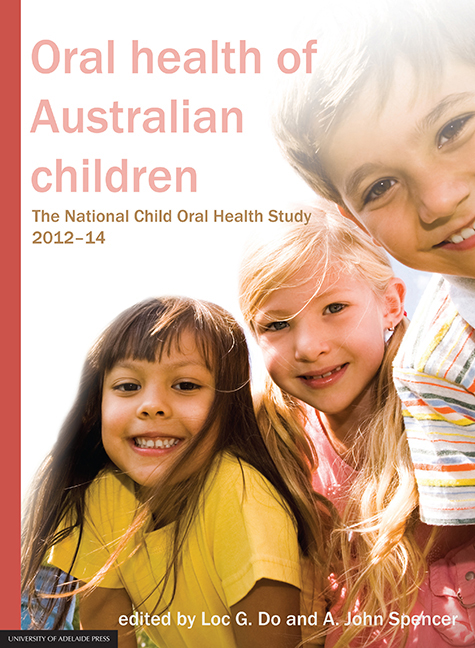Book contents
- Frontmatter
- List of Contributors
- Contents
- Preface
- Executive Summary
- 1 Children's oral health – assessing and improving oral health
- 2 Measuring child oral health and its influences
- 3 Data weighting, consideration and estimation procedures
- 4 Measuring representativeness of the study participants
- 5 Children's oral health status in Australia, 2012–14
- 6 Patterns of dental services use by Australian children
- 7 Australian children's oral health behaviours
- 8 Australian children's general health behaviours
- 9 Social gradients in child oral health
- 10 Oral health status and behaviours of Indigenous Australian children
- 11 Trends in child oral health in Australia
- 12 Interpretation of findings and a way forward to improving oral health and dental care
- 13 Appendix
- State and territory survey personnel
- Symbols
- Abbreviations
- Place names
- Glossary
- List of tables
- List of figures
6 - Patterns of dental services use by Australian children
Published online by Cambridge University Press: 05 September 2017
- Frontmatter
- List of Contributors
- Contents
- Preface
- Executive Summary
- 1 Children's oral health – assessing and improving oral health
- 2 Measuring child oral health and its influences
- 3 Data weighting, consideration and estimation procedures
- 4 Measuring representativeness of the study participants
- 5 Children's oral health status in Australia, 2012–14
- 6 Patterns of dental services use by Australian children
- 7 Australian children's oral health behaviours
- 8 Australian children's general health behaviours
- 9 Social gradients in child oral health
- 10 Oral health status and behaviours of Indigenous Australian children
- 11 Trends in child oral health in Australia
- 12 Interpretation of findings and a way forward to improving oral health and dental care
- 13 Appendix
- State and territory survey personnel
- Symbols
- Abbreviations
- Place names
- Glossary
- List of tables
- List of figures
Summary
Patterns of dental service use can be described using a range of approaches including measures related to first dental visit, usual dental visit pattern, and the most recent dental visit. First dental visit is considered important as it represents first contact with the dental system. The usual dental visit pattern of children is also of interest as it can reflect long-term attendance patterns. The most recent dental visit is considered important as it reflects current health behaviour.
In this chapter, measures related to first dental visit will be presented for: first making a dental visit before the age of 5 years, having a check-up as the reason for the first dental visit, and reporting having never made a dental visit. Information will also be presented related to usual dental visiting using the measure of irregular usual visit pattern. For the most recent dental visit: making a dental visit within the last 12 months, having a check-up as the reason for last dental visit, attending a private dental clinic at the last dental visit, whether parents or guardians attended with the child at their last dental visit, and rating of the last dental visit by the parent/guardian.
Frequency of dental visits and the reason for dental visits are key aspects related to access to dental care (Roberts-Thomson et al. 1995). Making a recent dental visit is indicative of access to the dental care system while visiting for the reason of a check-up is considered more likely to be associated with better health outcomes than visiting for a dental problem such as relief of pain (Crocombe et al. 2012). Hence, the dental profession tends to advocate a visit pattern of attending for annual dental check-ups to access preventive dental care or allow diagnosis of dental problems at an early stage, which can facilitate treatment before the disease progresses (Riley et al. 2013). For children, there are recommendations in relation to the desirability of making dental visits at an early age (Jones & Tomar 2005). While children who have not made a dental visit or report an irregular dental visit pattern could reflect a lack of perceived need, these measures could also reflect barriers to dental care that inhibit dental visiting or reflect problem-based attendance patterns.
- Type
- Chapter
- Information
- Oral Health of Australian ChildrenThe National Child Oral Health Study 2012-14, pp. 153 - 177Publisher: The University of Adelaide PressPrint publication year: 2016



